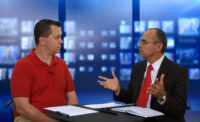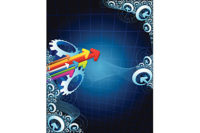Embracing Automation
By Bryan Salvage, Senior Editor
Further automating hog slaughter and pork fabrication makes dollars — and sense — for forward-thinking packers.
Although the pork-processing industry remains highly labor intensive, more automated equipment and systems have been developed and incorporated in recent years that benefit hog slaughter and pork fabrication operations, in particular. Further automation brings about more uniformity and consistency of product and helps to reduce labor costs.
“More than half of the costs in production plants are the costs of labor,” points out David Meisinger, assistant vice president of educational services for the National Pork Board (NPB).
Traceability is key
Traceability is becoming more important throughout the entire meat industry. Pork packers track hogs up to the time of slaughter through tatoos, but that identify is lost after that point. As a result, many packers have installed electronic tracking systems in their plants—usually an electric tag in the gambrel that allows a carcass to be tracked throughout the plant.
“Usually that ID is lost when that carcass comes off the gambrel in fabrication,” Meisinger says. “There’s a lot of activity in trying to find another way to identify a carcass and its parts through the fabrication process. Then you will be able to identify back to the farm.”
One new technology for U.S. pork packers more common in Europe is CO2 stunning; hogs in this country are generally electrically stunned.
“The Premium Standard Farms [PSF] plant in Clinton, NC, has the neatest, calmest stunning of hogs [using CO2 technology],” Meisinger says. “There is no squealing up until the time those pigs are killed.”
PSF’s Milan, MO, plant is the first hog slaughtering plant in this country to incorporate a CO2 anesthetizing system in the United States. The Clinton plant processes 9,100 pigs a day, and it uses the Butina CO2 anesthetizing system. The standard design of the Butina CO2 Backloader system is stainless and galvanized steel supplemented with solid and thoroughly tested standard components and technologies to prevent the pigs from getting stressed. Here’s how it works. The hogs are driven forward to a stunning system in groups of four to eight in a mechanical driveway through one or several push-hoist gates (PHG). The hogs are divided into tailored groups and driven into stunning boxes, which move down into the CO2-atmosphere by the paternoster or lift principle. After stunning, the hogs are tipped out from the stunning boxes for shackling and sticking. This system can manage from four to eight hogs a box and from 125 to 830 hogs an hour.
“It’s the neatest automated stunning system I’ve ever seen,” Meisinger says.
“It’s the neatest automated stunning system I’ve ever seen,” Meisinger says.
In recent decades, automated dehairing machines have come more into play, as well as automated hand-held equipment including head scissors and knives. During the last 10 years, packers have started experimenting with automatic splitters.
“In the beginning, they were maintenance challenges,” he says. “You’d have to have a maintenance person on-line dedicated to those machines. They have since improved, and some plants now routinely use automatic splitters. They alleviate needing several men on the line, and they make a more accurate split.”
Automated leaf-lard pullers are among the latest of technology. Leaf lard is the high-quality fat that’s deposited around some of the hog’s organs.
“That’s a really tough job [when done manually],” Meisinger says. “It’s hard on the employees — that job can pull your fingernails right off.”
Measuring carcass composition
Further automation has been benefiting the measurement of carcass composition. It was only about 10 years ago that technology like the Fat-O-Meter and other different probes came along for measuring composition, and then came AutoFom, Meisinger says. Denmark-based SFK Technology A/S, the developer of this technology, calls AutoFom the most advanced pork-grading system available. It provides fully automatic, three-dimensional (3-D) ultrasound scanning of carcasses and provides information about the total lean meat percentage, as well as the lean meat percentage in the ham, loin, shoulder, and belly.
AutoFom also determines the weight of the saleable meat in the entire carcass and in each of the four primals. Here’s how this process works. The ultrasonic image is generated by 16 transducers embedded in a stainless steel array. The system measures every 5 millimeters of the length of the carcass and every 25 millimeters of the width of the carcass. On a normal carcass, this results in about 3,000 total measurements. Thus, a 3-D image of the body is constructed.
An ultrasound-imaging machine like this one transmits high-frequency sound waves through tissues. Variations in the densities of bones, muscle, and fat cause echoes that can be converted into an image of the interior. Based on the image, a digital image and data analysis are performed.
“This technology really works well for characterizing carcass for composition,” Meisinger says.
“This technology really works well for characterizing carcass for composition,” Meisinger says.
Measuring quality
Systems for measuring quality are among the latest breakthroughs in the pork industry, and they include pH measurement. One pH device that has traditionally been used by almost every pork plant has a glass probe, Meisinger says, “and USDA is not excited about [packers] sticking a piece of glass into every carcass.”
“So it is not on-line or used in a continuous process; packers use it on a selected number of carcasses because it’s pretty accurate,” he says.
Work is being done to develop new pH probes without the glass probe.
Another indicator being pushed by one export customer in particular as a quality indicator is color.
Work is being done to develop new pH probes without the glass probe.
Another indicator being pushed by one export customer in particular as a quality indicator is color.
“The Japanese have pushed that in this country,” Meisinger says. “We have seen some hand-held colorimeters being used here. They’re good experimental laboratory models, but they’re not very good on-line.”
During the past year or so, new automated color-vision systems have been introduced.
During the past year or so, new automated color-vision systems have been introduced.
“They allow a packer to run a carcass surface by an instrument online on the conveyor belt,” Meisinger says. “It looks at the color and can even measure the color of the fat and lean and give you the lean-to-fat ratio in that product.”
This technology has been of interest to packers, and its use is increasing.
This technology has been of interest to packers, and its use is increasing.
“Right now we’re doing most color assessment on-line subjectively,” Meisinger says. “Having an instrument that can provide an objective measure makes sense.”
Use of robotics in pork processing is being hampered by the wide variation in U.S. pigs.
Use of robotics in pork processing is being hampered by the wide variation in U.S. pigs.
“We’re getting pigs that are, if anything, even more diverse than in the past because of different weights, extremes, and composition,” Meisinger says. And production practices have the barns cleaned out [in a fashion] that prevents more uniform pigs from being sent to a plant. [Any technology] that requires a carcass to be the same length, have the same amount of fat or composition or confirmation would be difficult [to employ in the pork-processing industry].”
The future
Areas in fabrication are ripe for further automation.
“We do a lot of skinning, boning, and trimming in fabrication, and a lot of this is hand work,” Meisinger says. “There is some automated ham and shoulder-boning equipment that works pretty well. You’ll see more of that type of equipment coming into play.”
When it comes to sizing-up new technology for future use, many pork executives will continue to look towards Europe.
“We do a lot of skinning, boning, and trimming in fabrication, and a lot of this is hand work,” Meisinger says. “There is some automated ham and shoulder-boning equipment that works pretty well. You’ll see more of that type of equipment coming into play.”
When it comes to sizing-up new technology for future use, many pork executives will continue to look towards Europe.
“Whenever anybody plans to build a new plant, they go on a fact-finding mission around Europe to see new technologies,” he says. “You only have to look across the water to see what our future [in technology use]might be.” NP


